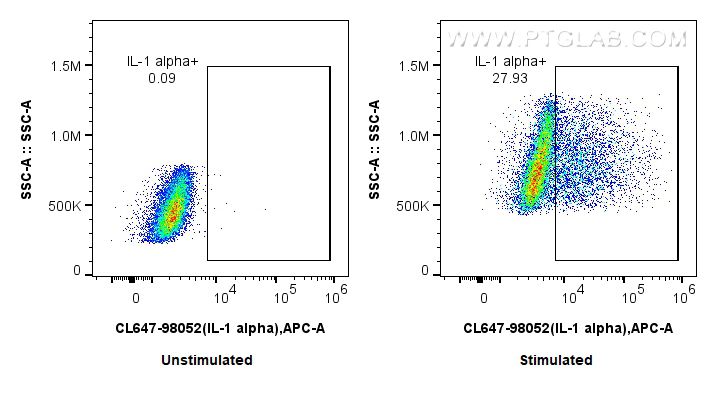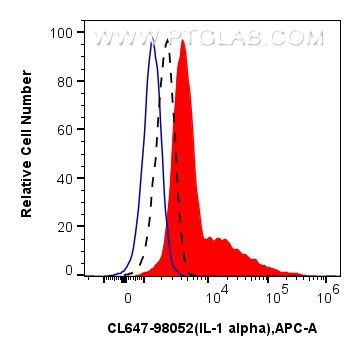Tested Applications
| Positive FC (Intra) detected in | LPS treated RAW 264.7 cells |
Recommended dilution
| Application | Dilution |
|---|---|
| Flow Cytometry (FC) (INTRA) | FC (INTRA) : 0.25 ug per 10^6 cells in a 100 µl suspension |
| This reagent has been tested for flow cytometric analysis. It is recommended that this reagent should be titrated in each testing system to obtain optimal results. | |
| Sample-dependent, Check data in validation data gallery. | |
Product Information
CL647-98052 targets IL-1 alpha in FC (Intra) applications and shows reactivity with mouse samples.
| Tested Reactivity | mouse |
| Host / Isotype | Rabbit / IgG |
| Class | Recombinant |
| Type | Antibody |
| Immunogen |
CatNo: Eg0263 Product name: Recombinant mouse IL1-alpha protein Source: mammalian cells-derived, pHZ-KIsec-C-6*HIS Tag: C-6*HIS Domain: 115-270 aa of NM_010554 Sequence: MSAPYTYQSDLRYKLMKLVRQKFVMNDSLNQTIYQDVDKHYLSTTWLNDLQQEVKFDMYAYSSGGDDSKYPVTLKISDSQLFVSAQGEDQPVLLKELPETPKLITGSETDLIFFWKSINSKNYFTSAAYPELFIATKEQSRVHLARGLPSMTDFQIS Predict reactive species |
| Full Name | interleukin 1 alpha |
| Calculated Molecular Weight | 31kd |
| GenBank Accession Number | NM_010554 |
| Gene Symbol | Il1a |
| Gene ID (NCBI) | 16175 |
| Conjugate | CoraLite® Plus 647 Fluorescent Dye |
| Excitation/Emission Maxima Wavelengths | 654 nm / 674 nm |
| Form | Liquid |
| Purification Method | Protein A purification |
| UNIPROT ID | P01582 |
| Storage Buffer | PBS with 0.09% sodium azide, pH 7.3. |
| Storage Conditions | Store at 2-8°C. Avoid exposure to light. Stable for one year after shipment. |
Background Information
IL-1 alpha is a dual function cytokine that can function both as a transcription factor and a damage-associated molecular pattern (DAMP) in innate immune responses. It is expressed by many cell types and its expression is increased when cells are exposed to growth factors, pro-inflammatory, and stress-related signals. In its pro-form, IL-1 alpha contains a nuclear localization signal that allows it to translocate to the nucleus and bind to DNA, resulting in either the increase or prohibition of pro-inflammatory cytokine expression. When cells are exposed to necrotic signals, mature IL-1 alpha is released from the cell lysates and triggers a strong pro-inflammatory response upon binding to its receptor on nearby cells. Due to its strongly pro-inflammatory nature, IL-1 alpha has been linked to tumor metastasis and lower median survival in several cancers (PMID: 27434011, 29247995).






